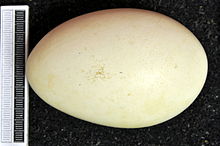Bean goose
| Bean goose | |
|---|---|

| |
Slimbridge Wildfowl and Wetlands Centre, Gloucestershire , England
| |

| |
| Scientific classification | |
| Kingdom: | |
| Phylum: | |
| Class: | |
| Order: | |
| Family: | |
| Subfamily: | |
| Tribe: | Anserini |
| Genus: | |
| Species | |
|
Taiga bean goose (Anser fabalis) | |
The bean goose (Anser fabalis or Anser serrirostris) is a
Description
The length ranges from 68 to 90 cm (27–35 in), wingspan from 140 to 174 cm (55–69 in) and weight from 1.7–4 kg (3.7–8.8 lb).
The upper wing-coverts are dark brown, as in the
The voice is a loud honking, higher pitched in the smaller subspecies.
The closely related pink-footed goose (A. brachyrhynchus) has the bill short, bright pink in the middle, and the feet also pink, the upper wing-coverts being nearly of the same bluish-grey as in the greylag goose. In size and bill structure, it is very similar to Anser fabalis rossicus, and in the past was often treated as a sixth subspecies of bean goose.
Reproduction
Bean goose mate for life, and they usually select their mates in the second winter of their lives. Bean goose use courtship to find mates, including a display of tail feathers. Once they chose their mates, they get together, put their heads close together, and sing to each other. This usually happens when a male chases off another male. This is performed throughout the birds lifetime.[3]
They breed yearly, and raise young together. Bean geese typically lay 4 to 6 eggs which are incubated for 27 to 29 days. Bean geese reach sexual maturity at three years.[3]
Taxonomy
The English and scientific names of the bean goose come from its habit in the past of grazing in bean field stubbles in winter. Anser is the Latin for "goose", and fabalis is derived from the Latin faba, a broad bean.[4]


There are five subspecies, with complex variation in body size and bill size and pattern; generally, size increases from north to south and from west to east. Some ornithologists (including AOU 2007) split them into two species based on breeding habitat, whether in forest bogs in the subarctic taiga, or on the arctic tundra. The taiga and tundra bean goose diverged about 2.5 million years ago and established secondary contact ca. 60,000 years ago, resulting in extensive gene flow.[5] The complex has included several contested species including Sushkin's goose (Anser neglectus).
- Taiga bean goose (Anser fabalis sensu stricto) (Latham, 1787)
- A. f. fabalis (Latham, 1787). Scandinavia east to the Urals. Large; bill long and narrow, with broad orange band. Anser fabalis fabalis is one of the species to which the Agreement on the Conservation of African-Eurasian Migratory Waterbirds (AEWA) applies.
- A. f. johanseni (Delacour, 1951). West Siberian taiga. Large; bill long and narrow, with narrow orange band.
- A. f. middendorffii (Severtzov, 1873). East Siberian taiga. Very large; bill long and stout, with narrow orange band.
- Tundra bean goose (Anser serrirostris, if treated as a distinct species) (Gould, 1852)
- A. s. rossicus (AEWA) applies.
- A. s. serrirostris (Gould, 1852). East Siberian tundra. Large; bill long and stout, with narrow orange band.
Distribution

This section needs expansion. You can help by adding to it. (April 2011) |
The bean goose is a rare winter visitor to
The Taiga bean geese Anser fabalis fabalis wintering in Europe are considered to migrate across three different flyways: Western, Central and Eastern; which has been confirmed by stable isotope analysis of their flight feathers.[6]
References
- . Retrieved 4 December 2023.
- ^ ISBN 978-0-8493-4258-5.
- ^ a b Clark, Emily. "Anser fabalis (bean goose)". Animal Diversity Web. Retrieved 15 May 2023.
- ISBN 978-1-4081-2501-4.
- PMID 32451423.
- .
Further reading
- Sangster, George; Oreel, Gerald J. (1996). "Progress in taxonomy of Taiga and Tundra Bean Geese". Dutch Birding. 18 (6): 310–316.
- Oates, John (1997). "Identification of Taiga Bean Goose and Tundra Bean Goose". Birding World. 10 (11): 421–426.
- Ruokonen, M.; Litvin, K.; Aarvak, T. (2008). "Taxonomy of the bean goose – pink-footed goose". PMID 18550388.
- Brown, Dan (2010). "Identification and taxonomy of bean geese". Birding World. 23 (3): 110–121.
External links
- RSPB Birds by Name – Bean Goose
- BirdGuides Bean Goose Page
- Cyberbirding: Bean Goose pictures
- BirdLife species factsheet for Anser fabalis
- "Anser fabalis". Avibase.
- "Bean goose media". Internet Bird Collection.
- Interactive range map of Anser fabalis at IUCN Red List maps
- Audio recordings of Taiga Bean goose on Xeno-canto.

